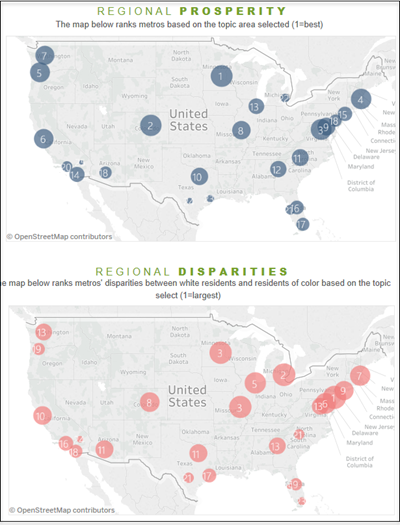Council’s interactive data visualization tells the story
“The more things change, the more they stay the same” could be the mantra describing racial disparities in the Twin Cities metro area.
 Met Council analyses of U.S. Census American Community Survey (ACS) show a consistent finding: while the Twin Cities area continues to rank highly among U.S. metro areas for our impressive employment and homeownership rates and low poverty rate, we also have the nation’s largest disparities between white residents and residents of color in these measures.
Met Council analyses of U.S. Census American Community Survey (ACS) show a consistent finding: while the Twin Cities area continues to rank highly among U.S. metro areas for our impressive employment and homeownership rates and low poverty rate, we also have the nation’s largest disparities between white residents and residents of color in these measures.
Despite gains among some groups on some measures, there have been no notable changes in the overall pattern of these racial and ethnic disparities, a testament to their persistence in the Twin Cities metro.
Further, this lack of substantive progress is unique: other metros have shown that they are closing gaps while we fall behind.
“As a region, we could gain so much if we performed better at mitigating our disparities,” said Libby Starling, Deputy Director of the Council’s Community Development Division.
“Our analyses show if we brought outcomes of people of color up to the levels of white residents by 2040, we would have 181,000 fewer people living in poverty, nearly 187,000 more homeowners, 80,000 more people holding jobs and $35.5 billion more earned in taxable income,” said Starling. “These factors affect the region’s livability, prosperity and well-being for everyone.”
The Council’s Research staff have published an interactive data visualization that includes the most recent (2017) ACS data.
Users can explore:
-
Rankings of other large U.S. metro areas with respect to poverty, income, employment, and homeownership between 1990 and 2017
-
Rankings of other large U.S. metro area in racial and ethnic disparities by poverty, income, employment, and homeownership between 1990 and 2017
-
Economic outcomes by race and ethnicity
-
What the Twin Cities region stands to gain from resolving racial and ethnic disparities
Council research staff expect to add additional information to the platform when additional ACS data are released in December.